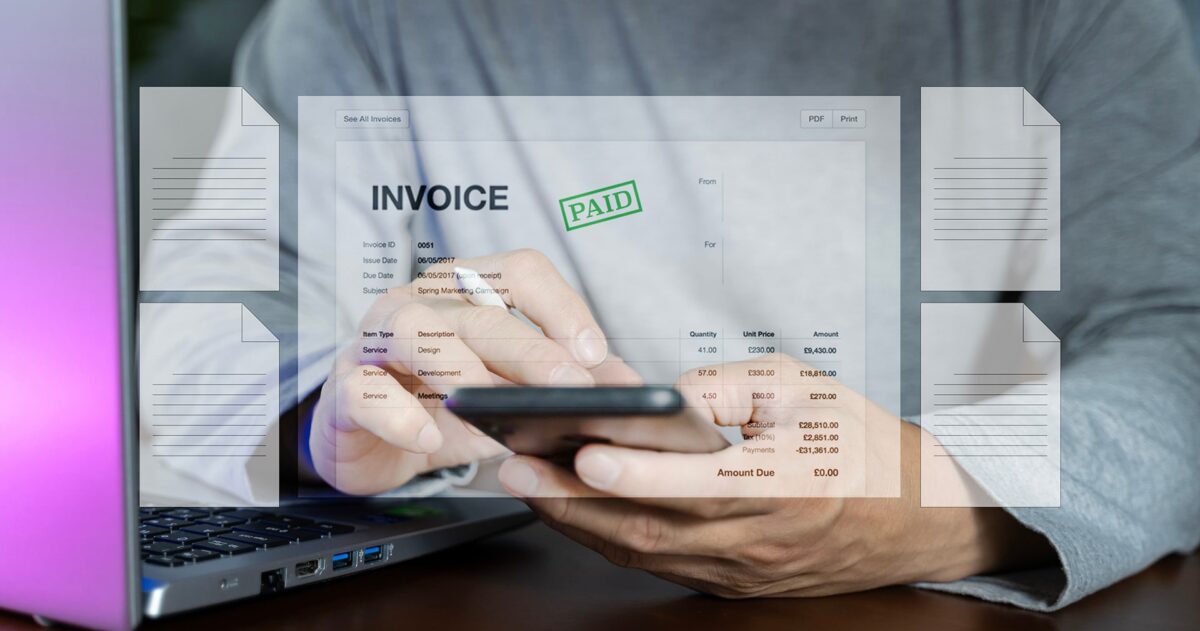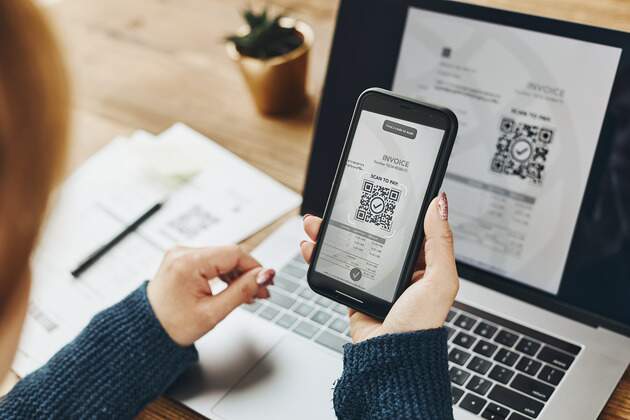How to Create an Invoice with Partial Payment Request

Partial payments are a common hedge against various risks. It’s common in industries like construction, where charging in full upfront is not a standard practice. According to Barclays, 58% of U.K. small and medium-size businesses were waiting on money tied up in outstanding invoices as of 2022.
Asking for a partial payment before starting a project can help even out your cash flow. It also establishes a bond of trust between you and the customer. Partial payments can also help pay for the materials associated with starting a project.
Does it sound like partial payments might be a good solution for your business? Do you need practical guidance on creating an invoice with a partial payment request? Keep reading for a full breakdown of partial payment invoicing.
See the difference between partial and full payment invoicing. Learn about the benefits of partial payments, the components of a partial payment invoice, and how to choose the right invoicing software to accommodate them.
Understanding Partial Payment Invoicing

It’s often said that a good compromise is when both parties are dissatisfied. While this may sound cynical, it reflects a fundamental truth about business dealings.
At least one party will always be taking a risk when two parties have never worked with each other or do not have established trust. Some business owners may be willing to gamble on a new client. However, most can’t afford to start work without some upfront payment.
Partial payments can be an effective compromise. As a sign of good faith, both parties agree to give something up in the interest of a mutually productive business relationship. Neither side is shouldering the whole burden. So, any potential losses to either party resulting from nonpayment or work stoppage are mitigated.
Partial payments may be a consideration for any size or type of project. They are most common with large projects and custom orders, though.
Service providers working on large projects often require installments to maintain a healthy cash flow. They’re necessary to cover the cost of materials and crew members associated with a job. These businesses will make use of partial payment invoicing regularly.
Partial payment amounts typically range from 10% on the low end to up to 50% on the high end. Factors influencing how much a service provider will charge for a partial payment include:
- The industry
- The region in which the business operates
- The size of the project
- Relevant laws limiting the amount a business may request for a down payment (where applicable)
In all cases, the contract with a client must include the partial payment amount and the schedule.
The Benefits of Offering Partial Payments

As mentioned, a big benefit of collecting partial payment at set intervals is improved cash flow for the service provider. Regular installments in the coffers allow you to pay for regular business expenses.
You can cover expenses like payroll and rent without having to dip into your business’ cash on hand or resorting to loans. Similarly, a partial payment upfront can help you cover any materials required to complete a client project.
A partial payment plan can also improve customer satisfaction through enhanced financial flexibility. Not every potential customer is willing or able to cough up all the money required to pay for a project immediately. If your company needs or wants these customers’ business, it makes sense to work with them by allowing installment payments.
A less obvious benefit of partial payments is promoting stronger client relationships. Requiring a partial payment upfront actually ensures clients are invested in the project.
A client who has already put a sizeable payment down on a project is far less likely to back out. They are also more likely to continue paying after you’ve invested time and resources into a project. Partial payment requires preselecting the best customers. Those who are motivated and in good financial standing are good candidates.
Components of a Partial Payment Invoice

So, you’re sold on the idea of partial payments and their benefits. But the question remains: How do you create an invoice with partial payment?
A proper partial payment invoice will include all of the following elements:
- Total amount: This is the full amount the customer will pay after you complete the project according to the statement of work.
- Partial payment amount: This states what proportion of the total amount is due per your contract with the customer.
- Due date: A proper partial payment invoice will make the date by which payment is due prominent.
- Breakdown of services provided: If the partial payment invoice is for an upfront payment, this section should include all the services your business will provide contingent on your business receiving the payment by the due date. For an installment payment, the invoice should detail the work completed. Then, detail the agreed-upon milestone prompting the invoice.
These elements are in addition to basic invoice requirements. As always, include:
- The invoice number and date
- Your business address
- Your customer’s name and address
On top of these elements, many partial payment invoices will also include relevant legal or contractual language. Certain language may be advisable or required depending on the industry or work jurisdiction. Always check your jurisdiction’s legal code.
If necessary, consider scheduling some time with an attorney familiar with your industry to ensure you comply with all applicable laws relating to your invoicing practice.
Now, we’ve covered the basics of how to create an invoice with partial payment requests. Let’s continue with four steps to start a successful partial payments program.
Step 1: Establish Your Partial Payments Policy
If your business is just starting to request partial payments, the process will likely involve some give and take.
For instance, existing clients accustomed to paying in full upon completion may be surprised when you ask for upfront payments. Even with new clients, you may be unsure about how much to ask for. You may also be uncomfortable requesting a partial payment if you’ve never done something like that before.
All this is normal. Know that the more you ask, the better idea you’ll have about how much to ask for a partial payment and how to do the asking. For benchmarks and additional guidance, you can always consult industry groups you’re a part of. You can also turn to publications catering to businesses in your industry.
Whatever partial payment arrangement you settle upon, include the full terms in your customer contracts. Take the time to review them with your customers to ensure no one is surprised when you ultimately send over that invoice.
Step 2: Choose the Right Invoice Software
Choosing the right invoice software is critical. It simplifies partial payment management as well as accounting and record-keeping.
Invoicing software that supports partial invoices and automates the process will be a major asset as you begin to accept partial payments. If the software fully integrates with your small business finance solution, even better.
When evaluating an automated partial payments invoice software, you’ll want to be on the lookout for handy features like:
- Notifications when your invoices are delivered and read
- An easy-to-use interface displaying when invoices are due and which are still unpaid
- Automatically generated reporting that breaks down monthly and yearly income, your top clients by revenue, and other business trends
- The ability to export and send reports to your accountant or other members of your team with a single click (which saves time on bookkeeping and taxes)
- The ability to request a deposit from your customers
Step 3: Communicate with Your Client
When it comes to partial payment invoices, transparency and open communication should be your guiding values. Introducing the idea of an upfront payment as soon as the topics of fees and costs arise will help ensure no surprises when you start drawing up payment terms.
If pushback does arise, open communication is your best tool. For instance, if you’re a construction professional, explain that before work starts, you must add the customer to your schedule, assemble a crew, and procure materials and equipment. Explain that the customer’s down payment enables the project to get off the ground.
It may also be helpful to point your customer toward authoritative publications that include industry benchmarks for partial payment invoicing. Show that your upfront payment and/or installment plan align with standard industry practices.
Step 4: Manage Follow-Up and Receipts
After sending your partial payment invoices, the next step is managing those invoices. You expect your customers to be proactive with sending payments. So, you must do your due diligence and mark payments complete as soon as they’ve cleared.
The right invoicing software can expedite this process. It should automatically send confirmations to clients as soon as you check them off.
Additionally, make it a habit to check the status of your invoices. Ensure you follow up on any outstanding payments. Set predefined timetables for follow-ups.
Intervals such as 10 days, 3 days, and 1 day before the payment is due can give you and your team a guide for tracking payments. It also ensures no one feels nagged. Even better, a good automated invoice software will take care of these actions. That frees up your time to focus on the important things.
How to Create an Invoice with Partial Payment: Closing Thoughts

Many day-to-day transactions involve one party paying another party a full amount all at once. However, there are many industries where a partial payment request is common practice.
Remember, the success of partial payment programs depends largely on clear communication. It requires detailed record-keeping and consistent adherence to established policies. As you start to request partial payments for your services, always be prepared to adapt your approach based on client feedback and the evolving needs of your business.
Need to create an invoice for a partial payment request? Invoice Simple can help. Learn More
Start Your First
Invoice Today
Create customized and professional
invoices and connect with clients








